#Salsette 27
Explore tagged Tumblr posts
Text

Booking Now Salsette 27 in Byculla. The apartment is Peninsula by Salsette 2BHK, 3BHK Flat check Price, Floor Plan, Brochure, and amenities.
0 notes
Text
Salsette 27 in Byculla: Premium 2 BHK and 3 BHK Flats in Byculla

Salsette 27 stands as a premier residential development in the heart of Byculla, Mumbai. As a distinguished project by Peninsula Land Ltd., Salsette 27 offers a blend of luxury, convenience, and modernity, setting a new benchmark in the real estate market. This article delves into the unique features of Salsette 27, highlighting its 2 BHK and 3 BHK flats, and provides a comprehensive overview of the floor plans and amenities that make it a desirable residential choice.
Salsette 27 is strategically located in Byculla, one of Mumbai's most vibrant and historical neighborhoods. The project features contemporary architecture and an array of high-end amenities that cater to the modern lifestyle. The residential complex is designed to offer an unparalleled living experience, blending elegance with functionality.
Prime Location and Connectivity
Situated in Byculla, Salsette 27 benefits from its proximity to major commercial hubs, educational institutions, and healthcare facilities. The location offers excellent connectivity to different parts of Mumbai via road and rail, making it a strategic choice for professionals and families alike.
Luxurious 2 BHK and 3 BHK Flats
Salsette 27 offers a range of residential options, including 2 BHK and 3 BHK flats, each meticulously designed to provide maximum comfort and convenience.
2 BHK Flats: Space and Elegance
The 2 BHK in Byculla are designed for those seeking a blend of spacious living and elegant design. These flats feature:
Open-Plan Living Areas: Spacious living and dining areas designed for comfort and functionality.
Modern Kitchens: Equipped with contemporary fixtures and fittings to make cooking a delightful experience.
Master Bedrooms: Designed with ample space and high-quality finishes for a restful retreat.
Balconies with Views: Offering panoramic views of the cityscape, adding a touch of luxury to everyday living.
3 BHK Flats: Ultimate Luxury
For those seeking more space, the 3 BHK flats in Salsette 27 offer a higher level of luxury and comfort. Key features include:
Expansive Living Areas: Generous living and dining spaces perfect for hosting gatherings.
Gourmet Kitchens: Featuring high-end appliances and finishes for an exceptional cooking experience.
Spacious Master Suite: Includes a private dressing area and en-suite bathroom.
Additional Bedrooms: Designed to offer privacy and comfort for family members or guests.
Large Balconies: Providing additional space for relaxation and outdoor dining with stunning views.
Floor Plans of Salsette 27
Detailed Layouts
The floor plans of Salsette 27 are designed to optimize space utilization and ensure flow and functionality. Each unit features:
Efficient Space Management: Ensuring that every square foot is used effectively.
Flexible Layouts: Offering options to personalize the living space according to individual needs.
Premium Finishes: High-quality materials and finishes that reflect luxury and sophistication.
Amenities and Facilities
Salsette 27 is not just about luxurious living spaces; it also offers a range of world-class amenities designed to enhance the quality of life for its residents.
Clubhouse and Recreational Facilities
The clubhouse at Salsette 27 provides a range of recreational options, including:
Swimming Pool: A beautifully designed pool for relaxation and exercise.
Fitness Center: Equipped with state-of-the-art gym equipment.
Community Hall: Ideal for social gatherings and events.
Conclusion
Salsette 27 Property in Byculla represents the pinnacle of luxury living in Mumbai. With its elegant design, spacious 2 BHK and 3 BHK flats, and world-class amenities, it offers an unparalleled residential experience. Whether you're looking for a new home or a lucrative investment opportunity, Salsette 27 is a choice that combines comfort, style, and value.
For more details visit our site: https://www.propmart.co/city/byculla/
0 notes
Text

Salsette27 is a residential project offering 2 BHK and 3 BHK luxury flats in Byculla in South Mumbai by Peninsula Land. Know more by visiting our website
0 notes
Text
Unveiling Salsette 27: A Luxurious Haven in Byculla
Nestled in the heart of Mumbai’s vibrant landscape, Salsette 27 stands tall as an epitome of luxury living. This opulent property, located in Byculla, sets a new benchmark in sophistication, offering a range of meticulously designed 2BHK and 3BHK apartments that redefine contemporary urban living.
Architecture and Design
The architecture of Salsette 27 is a seamless blend of modern aesthetics and classic elegance. Designed by acclaimed architects, the property boasts a striking façade that catches the eye from afar. As you step inside, the grandeur of the interiors leaves a lasting impression. The floor plans are thoughtfully crafted to optimize space, ensuring a harmonious balance between functionality and luxury.
It has Commercial Hub as,
Mazgaon Dock Shipbuilders (1.4 Km)
World Trade Centre (7.2 Km)
Maker Chambers (6.0 Km)
Indiabulls Finance Centre (3.6 Km)
Peninsula Corporate Park (2.8 Km)
2BHK and 3BHK Apartments
Salsette 27 offers a diverse range of apartments, catering to various lifestyle needs. The 2BHK units are spaciously laid out, ideal for young professionals or small families seeking comfort and style. The 3BHK Flat in Byculla , designed for larger families, offer generous living spaces and exquisite detailing that excude sophistication. For those seeking ultimate luxury, units present a lavish haven, featuring expensive rooms and premium finishes.
Location
Situated in the upscale locale of Byculla, Salsette 27 offers the perfect blend of convenience and luxury. Surrounded by cultural landmarks, educational institutions, healthcare facilities, and shopping centers, residents experience the vibrancy of Mumbai while enjoying the tranquility of a well-planned residential enclave at Properties in Byculla.
Amenities
Beyond its elegant architecture and well-designed interiors, Salsette 27 elevates living standards with its world-class amenities.
24x7 Electricity
Children's play area
24X7 Water Supply
Clubhouse
Swimming Pool
Conclusion
Salsette 27 isn’t just a residential property; it’s a statement of sophistication and exclusivity. With its meticulously crafted floor plans, luxurious amenities, and prime location, it caters to the discerning tastes of those seeking a life of elegance and comfort in the heart of Mumbai.
Whether it's the allure of a spacious 2BHK, the indulgence of a sprawling 4BHK, or anything in between, Salsette 27 promises an unparalleled living experience, redefining luxury living in Byculla.
If you aspire to live amidst opulence and sophistication, Salsette 27 awaits to welcome you home.
For more Details, Visit our Website: https://www.propmart.co/city/byculla/
0 notes
Photo

Salsette 27 by Peninsula Land is luxury residential community offering Property in 3bhk starting from 6.85CR and 2 bhk in Byculla ,South Central Mumbai @ 4.85 Cr.
0 notes
Text

Booking Now Salsette 27 in Byculla. The apartment is Peninsula by Salsette 2BHK, 3BHK Flat check Price, Floor Plan, Brochure, and amenities
0 notes
Text
Discover the Luxurious Living Experience at Peninsula Salsette 27 |
Experience unparalleled luxury living at Peninsula Salsette 27. Located in the heart of the city, Peninsula Salsette 27 offers exquisite residences with world-class amenities and breathtaking views. From spacious interiors to state-of-the-art facilities, every detail is designed to enhance your lifestyle. Explore the epitome of elegance and sophistication at Peninsula Salsette 27. Visit RowdyTech for more information on this prestigious residential development.
0 notes
Text

Saint of the day July 27
Bl. Rudolf Acquaviva, Roman Catholic Jesuit Priest and Martyr. he was the nephew of Claudius Acquaviva, the fifth master general of the Jesuits, and he followed his uncle into the Society of Jesus. In 1549, he was sent to India, going to the court of Mogul Akbar near Agra. He became superior of the Salsette mission. Rudolf was martyred at Salsette, near Goa, by Hindus, with four companions, including Alfonso Pacheco. Feastday: July 27 https://en.wikipedia.org/wiki/Rodolfo_Acquaviva
St. Anthusa, Roman Catholic Abbess tortured by the Byzantine Emperor Constantine V. Anthusa was originally a hermitess, becoming abbess of the convent near Constantinople. Because of her veneration of sacred images, she was arrested by the emperor, who, as an ardent iconoclast, opposed such sacramentals. Anthusa was tortured severely until the empress intervened and secured her release. Feastday: July 27 https://www.newmanministry.com/saints/saint-anthusa#:~:text=Anthusa%20was%20the%20daughter%20of,and%20asked%20for%20her%20prayers.
Sts. Natalie & Aurelius, Roman Catholic Martyrs for her Faith with her husband Aurelius. According to his biography by St. Eulogius of Toledo, Aurelius was the son of a Moor and a Spanish woman, and was orphaned as a child. He was secretly raised a Christian by his aunt during the Moorish persecution of Christians. He married a half Moorish woman, Sabigotho, who took the name Natalie when he converted her to Christianity. They were both beheaded for practicing their religion openly together with George, a monk from Jerusalem whom Aurelius had befriended. FeastdayJuly 27th https://en.wikipedia.org/wiki/Aurelius_and_Natalia#:~:text=Aurelius%20and%20Natalie%20(died%20852,among%20the%20Martyrs%20of%20C%C3%B3rdoba.&text=Aurelius%20was%20the%20son%20of%20a%20Muslim%20father%20and%20a%20Christian%20mother.
ST. CELESTIN I, POPE, https://en.wikipedia.org/wiki/Pope_Celestine_I
ST. SIMEON STYLITES, https://en.wikipedia.org/wiki/Simeon_Stylites
ST. PANTALEON, PHYSICIAN, MARTYR https://en.wikipedia.org/wiki/Saint_Pantaleon#:~:text=Saint%20Pantaleon%20(Greek%3A%20%CE%A0%CE%B1%CE%BD%CF%84%CE%B5%CE%BB%CE%B5%CE%AE%CE%BC%CF%89%CE%BD%2C,Diocletianic%20Persecution%20of%20305%20AD.
0 notes
Text
INDIAN ROCK-CUT ARCHITECTURE
INCREDIBLE INDIA BEYOND AND BEFORE TAJ MAHAL
Taj Mahal – one of the seven wonders of the world, undoubtedly is one of the best things to see in India. I just mentioned one of the best…yes, you know why – with-out any doubt, there are so many places in India which are just over-shadowed because of the Taj. Don’t mind, being in Travel business I too love Taj, I’ve already been to Taj so many times and taken hundreds of Tourists to experience this wonderful, timeless magic now and yet never get enough of it. The reality is that India is a diverse, multi-cultured nation, despite this tourists usually prefer Taj and combines it with Jaipur and Delhi at max. Isn’t it unfair to other parts of India with immense beauty receives a cold-shoulder! There are so many places to visit in India beyond just the iconic Taj Mahal which make India as Bucket of Incredible India
Here I would try my best to Highlight Few Places and Monuments undoubtedly equally beautiful Taj, an example itself of Ancient Indian Architects glorifying Indian craftsmanship, technology and Hardship Where Rock-Cut Architect was introduced before 3rd century B.C.
INDIAN ROCK-CUT ARCHITECTURE:
Indian rock-cut architecture is more various and found in greater abundance in India than any other form of rock-cut architecture around the world. Rock-cut architecture is the practice of creating a structure by carving it out of solid natural rock. Rock that is not part of the structure is removed until the only rock left makes up the architectural elements of the excavated interior. Indian rock-cut architecture is mostly religious in nature.
As per historical evidence available there are more than 1,500 known rock-cut structures in India. Many of these structures contain artwork of global importance, and most are adorned with exquisite stone carvings. These ancient and medieval structures represent significant achievements of structural engineering and craftsmanship. The effort expended often astonishes visitors, but seen from one aspect, a rock-cut structure is a decorated rock quarry; most of the stone removed was typically put to economic use elsewhere.
Few of Rock-cut monuments in India:
Badami Cave Temples : (HANDCRAFTED WONDER)
The Badami cave temples are a complex of Hindu and Jain cave temples located in Badami, a town in the Bagalkot district in northern part of Karnataka, India. The caves are considered an example of Indian rock-cut architecture, especially Badami Chalukya architecture, which dates from the 6th century. Badami was previously known as Vataapi Badami, the capital of the early Chalukya dynasty, which ruled much of Karnataka from the 6th to the 8th century. Badami is situated on the west bank of a man-made lake ringed by an earthen wall with stone steps; it is surrounded on the north and south by forts built in later times.
The Badami cave temples represent some of the earliest known examples of Hindu temples in the Deccan region. They along with the temples in Aihole transformed the Malaprabha River valley into a cradle of temple architecture that influenced the components of later Hindu temples elsewhere in India.
Caves 1 to 4 are in the escarpment of the hill in soft Badami sandstone formation, to the south-east of the town. In Cave 1, among various sculptures of Hindu divinities and themes, a prominent carving is of the Tandava-dancing Shiva as Nataraja. Cave 2 is mostly similar to Cave 1 in terms of its layout and dimensions, featuring Hindu subjects of which the relief of Vishnu as Trivikrama is the largest. The largest cave is Cave 3, featuring Vishnu-related mythology, and it is also the most intricately carved cave in the complex. Cave 4 is dedicated to revered figures of Jainism. Around the lake, Badami has additional caves of which one may be a Buddhist cave. Another cave was discovered in 2015, about 500 metres (1,600 ft) from the four main caves, with 27 Hindu carvings.

Bagh Caves
The Bagh Caves are a group of nine rock-cut monuments, situated among the southern slopes of the Vindhyas in Bagh town of Dhar district in Madhya Pradesh state in central India. These monuments are located at a distance of 97 km from Dhar town.

Ellora Caves
Ellora (एलोरा) is a UNESCO World Heritage Site located in the Aurangabad district of Maharashtra, India. It is one of the largest rock-cut monastery-temple cave complexes in the world, featuring Hindu, Buddhist and Jain monuments, and artwork, dating from the 600–1000 CE period. Cave 16, in particular, features the largest single monolithic rock excavation in the world, the Kailasha temple, a chariot shaped monument dedicated to Lord Shiva. The Kailasha temple excavation also features sculptures depicting the gods, goddesses and mythologies found in Vaishnavism, Shaktism as well as relief panels summarizing the two major Hindu Epics.
Although the caves served as monasteries, temples and a rest stop for pilgrims, the site's location on an ancient South Asian trade route also made it an important commercial centre in the Deccan region. It is 29 kilometres (18 miles) north-west of Aurangabad, and about 300 kilometres (190 miles) east-northeast of Mumbai. Today, the Ellora Caves, along with the nearby Ajanta Caves, are a major tourist attraction in the Marathwada region of Maharashtra and a protected monument under the Archaeological Survey of India.

Gopachal
Siddhachal Caves or Gopachal Rockcut monuments are Jain cave monuments and statues carved into the rock face inside the Urvahi valley of the Gwalior Fort in northern Madhya Pradesh, India. There are the most visited among the five groups of Jain rock carvings on the Gwalior Fort hill. They were built over time starting in the 7th-century, but most are dated to the 15th-century CE. Many of the statues were defaced and destroyed under the orders of the Muslim Emperor Babur of the Mughal dynasty in the 16th century, while a few repaired and restored after the fall of the Mughal dynasty and through the late 19th century.
The statues depict all 24 Tirthankaras. They are shown in both seated Padmasana posture as well as standing Kayotsarga posture, in the typical naked form of Jain iconography. The reliefs behind some of them narrate scenes from the Jain legends. The site is about 2 kilometres (1.2 mi) from the South-East Group of Gopachal rock cut Jain monuments and about 1 kilometre (0.62 mi) northwest of the Teli ka Mandir within the Gwalior Fort.
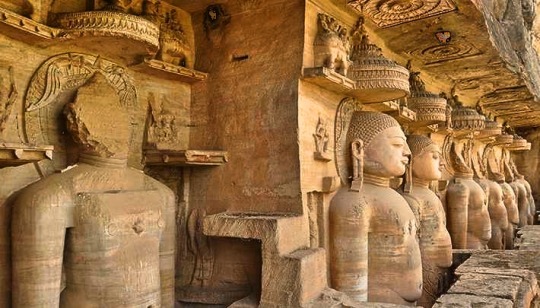
Kanheri Caves
The Kanheri Caves (Kānherī-guhāḥ) are a group of caves and rock-cut monuments cut into a massive basalt outcrop in the forests of the Sanjay Gandhi National Park, on the former island of Salsette in the western outskirts of Mumbai, India. They contain Buddhist sculptures and relief carvings, paintings and inscriptions, dating from the 1st century CE to the 10th century CE. Kanheri comes from the Sanskrit Krishnagiri, which means black mountain.
The site is on a hillside, and is accessible via rock-cut steps. The cave complex comprises one hundred and nine caves. The oldest are relatively plain and unadorned, in contrast to later caves on the site, and the highly embellished Elephanta Caves of Mumbai. Each cave has a stone plinth that functioned as a bed. A congregation hall with huge stone pillars contains a stupa (a Buddhist shrine). Rock-cut channels above the caves fed rainwater into cisterns, which provided the complex with water. Once the caves were converted to permanent monasteries, their walls were carved with intricate reliefs of Buddha and the Bodhisattvas. Kanheri had become an important Buddhist settlement on the Konkan coast by the 3rd century CE.
Most of the caves were Buddhist viharas, meant for living, studying, and meditating. The larger caves, which functioned as chaityas, or halls for congregational worship, are lined with intricately carved Buddhist sculptures, reliefs, pillars and rock-cut stupas. Avalokiteshwara is the most distinctive figure. The large number of viharas demonstrates there was a well organized establishment of Buddhist monks. This establishment was also connected with many trade centers, such as the ports of Sopara, Kalyan, Nasik, Paithan and Ujjain. Kanheri was a University center by the time the area was under the rule of the Maurayan and Kushan empires In the late 10th century, the Buddhist teacher Atisha (980–1054) came to the Krishnagiri Vihara to study Buddhist meditation under Rahulagupta.

Lenyadri Caves
Lenyadri, sometimes called Ganesa Lena, Ganesh Pahar Caves, or Suleman Caves, represents a series of about 30 rock-cut Buddhist caves, located about 5km north of Junnar in Pune district in the Indian state of Maharashtra. Other caves surrounding the city of Junnar are: Manmodi Caves, Shivneri Caves and Tulja Caves.
· Cave 7, originally a Buddhist vihara, has been adapted as a Hindu temple dedicated to the god Ganesha. It is one of the Ashtavinayak shrines, a set of the eight prominent Ganesha shrines in Western Maharashtra. Twenty-six of the caves are individually numbered. The caves face to the south and are numbered serially from east to west. Caves 6 and 14 are chaitya-grihas (chapels), while the rest are viharas (dwellings for monks). The latter are in the form of dwellings and cells. There are also several rock-cut water cisterns; two of them have inscriptions. The layout of the caves, in general, are similar in pattern and shape. They generally have one or two sides with two long benches for occupants' use.
The caves date from between the 1st and 3rd century AD; the Ganesha shrine situated in Cave 7 is dated to the 1st century AD, though the date of conversion to a Hindu shrine is unknown. All of the caves arise from Hinayana Buddhism
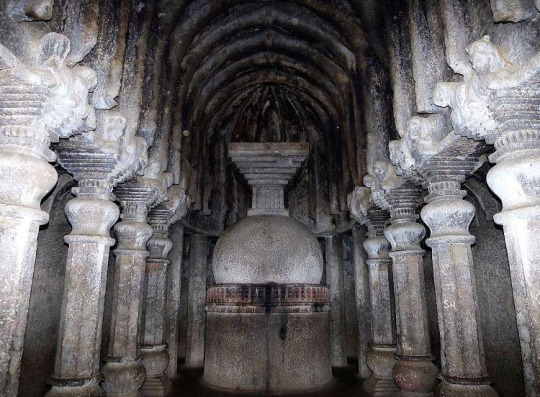
Mahabalipuram Caves
The Group of Monuments at Mahabalipuram is a collection of 7th- and 8th-century CE religious monuments in the coastal resort town of Mahabalipuram, Tamil Nadu, India and a UNESCO World Heritage Site. It is on the Coromandel Coast of the Bay of Bengal, about 60 kilometres (37 mi) south of Chennai.
The site has 40 ancient monuments and Hindu temples, including one of the largest open-air rock reliefs in the world: the Descent of the Ganges or Arjuna's Penance. The group contains several categories of monuments: ratha temples with monolithic processional chariots, built between 630 and 668; mandapa viharas (cave temples) with narratives from the Mahabharata and Shaivic, Shakti and Vaishna inscriptions in a number of Indian languages and scripts; rock reliefs (particularly bas-reliefs); stone-cut temples built between 695 and 722, and archaeological excavations dated to the 6th century and earlier.The monuments were built during the Pallava dynasty. Known as the Seven Pagodas in many colonial-era publications, they are also called the Mamallapuram temples or Mahabalipuram temples in contemporary literature. The site, restored after 1960, has been managed by the Archaeological Survey of India.

Pancha Rathas
Pancha Rathas (also known as Five Rathas or Pandava Rathas) is a monument complex at Mahabalipuram, on the Coromandel Coast of the Bay of Bengal, in the Kancheepuram district of the state of Tamil Nadu, India. Pancha Rathas is an example of monolithic Indian rock-cut architecture. The complex was carved during the reign of King Narasimhavarman I (630–668 AD): the idea of realising monolithic buildings, an innovation in Indian architecture, is attributed to this ruler. The complex is under the auspices of the Archaeological Survey of India (ASI) and is part of the UNESCO World Heritage site inscribed by UNESCO as Group of Monuments at Mahabalipuram.
Each of the five monuments in the Pancha Rathas complex resembles a chariot (ratha), and each is carved over a single, long stone or monolith, of granite which slopes in north-south direction with a slight incline. Though sometimes mistakenly referred to as temples, the structures were never consecrated because they were never completed following the death of Narasimhavarman I The structures are named after the Pancha Pandavas and their common wife Draupadi, of epic Mahabharata fame. In order of their size, they include the Dharmaraja Ratha, Bhima Ratha, Arjuna Ratha, Nakula Sahadeva Ratha, and Draupadi Ratha.

Kazhuku Malai
The Sculptures in the only single-stone temple car at Kazhuku Vettuvan Coil are discussed. Also described are the sculptures, the paintings and the storeyed temple of Pandyas.The five core units of the sculptures in cave temples, in single-stone temple cars, in built-up temples, in the eight storeyed temple towers, and paintings of the Pandya period. The cave-temple tradition of the Pallavas was followed and perfected by the Pandyas. The first Pandya cave-temple is in Malakadikurichi of Tirunelveli District. Cave-temples at places like Othakadai in Madurai District, Thirupparankundram, Pillayarpatti Cave-temple near Karaikudi, Kundrakudi, Trichy, and ��Chokkampatti have numerous sculptures in them.The Single-stone temple car sculptures at Kazhukumalai in Tirunelveli District earned the name “Southern Ellora” for the place. Paintings of the early Pandyas, sculptures of building type at Kazhukumalai, a few remnants of early Pandyas’ built-up temples, temple-towers and Mandapas constructed by later Pandyas and also their paintings reveal the interest of Pandyas in these arts.

Pandavleni Caves
The Nasik Caves, or sometimes Pandavleni Caves (or Pandu Lena,[1] Pandu Caves or Trirashmi Leni, Trirashmi being the name of the hills in which the caves are located, Leni being a Marathi word for caves), are a group of 24 caves carved between the 1st century BCE and the 3rd century CE, though additional sculptures were added up to about the 6th century, reflecting changes in Buddhist devotional practices mainly. Buddhist sculptures are a significant group of early examples of Indian rock-cut architecture initially representing the Hinayana tradition. Most of the caves are viharas except for Cave 18 which is a chaitya of the 1st century BCE. The style of some of the elaborate pillars or columns, for example in caves 3 and 10, is an important example of the development of the form. The location of the caves is a holy Buddhist site and is located about 8 km south of the center of Nashik (or Nasik), Maharashtra, India, The "Pandavleni" name sometimes given to the Nasik Caves has nothing to do with the characters Pandavas, characters in the Mahabharata epic. Other caves in the area are Karla Caves, Bhaja Caves, Patan Cave and Bedse Caves.

Pitalkhora
The Pitalkhora Caves, in the Satamala range of the Western Ghats of Maharashtra, India, are an ancient Buddhist site consisting of 14 rock-cut cave monuments which date back to the third century BCE, making them one of the earliest examples of rock-cut architecture in India. Located about 40 kilometers from Ellora, the site is reached by a steep climb down a flight of concrete stairs, past a waterfall next to the caves.The caves are cut in a variety of basalt rock, but some of the caves have crumbled and are damaged. Out of the 14, four are chaityas (one housing votive stupas, one apsidal and single-cell) and the rest are viharas. All the caves belong to the Hinayana period, but the reasonably well preserved paintings are of the Mahayana period. The caves are in two groups, one of 10 caves and the second of four. It is believed that Pitalkhora can be identified with Ptolemy’s "Petrigala" as well as the "Pitangalya" of Mahamayuri, a Buddhist chronicle. The inscriptions date from c. 250 BCE to the 3rd and 4th centuries CE.
The site shows statues of elephants, two soldiers of which one is intact, a damaged Gaja Lakshmi icon, and an ancient rainwater harvesting system. These caves have been significant in helping establish the chronology of cave building in the Ajanta-Ellora region.

Undavalli caves,
The Undavalli Caves, a monolithic example of Indian rock-cut architecture and one of the finest testimonials to ancient viswakarma sthapathis, are located in Undavalli of Guntur district in the Indian state of Andhra Pradesh. The caves are located 6 km south west from Vijayawada, 22 km north east of Guntur City of Andhra Pradesh. It is one of the centrally protected monuments of national importance.These caves are said to be found in 7th century. They are associated with the Vishnukundi kings of 420-620 CE. These caves are dedicated to Anantha Padmanabha and Lord Narashimha. Buddhist monks used these as rest houses.
These caves were carved out of solid sandstone on a hillside in the 4th to 5th centuries CE. There are several caves and the best known largest one has four stories with a huge recreated statue of Vishnu in a reclining posture, sculpted from a single block of granite inside the second floor. Many Buddhist artifacts and stupas in Andhra were converted into Hindu temples and deities and undavalli is an example. It was originally a Jain cave resembling the architecture of Udayagiri and Khandgiri..The main cave is one of the earliest examples of Gupta architecture, primarily primitive rock-cut monastery cells carved into the sandstone hills. Initially, the caves were shaped as a Jain abode and the first-floor abode still retains the Jain style; the vihara exhibits Jain monastics and includes tirthankara sculptures. This first level of the cave is a carved vihara and includes Buddhist artwork. The site served as the Bhikkhu monastic complex during ancient period. The walls of the caves display sculptures carved by skilled craftsmen. The caves are surrounded by green countryside. From the high hill above the cave overlooking the Krishna River many fine specimens of rock-cut architecture can be seen.
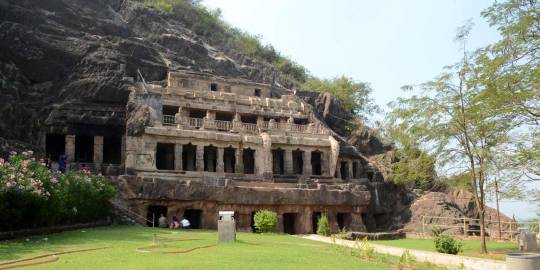
Varaha Cave Temple
Varaha Cave Temple (also Varaha Mandapa) is a rock-cut cave temple located at Mamallapuram, on the Coromandel Coast of the Bay of Bengal in Kancheepuram District in Tamil Nadu, India. It is part of the hill top village, which is 4 kilometres (2.5 mi) to the north of the main Mahabalipurm sites of rathas and the Shore Temple. It is an example of Indian rock-cut architecture dating from the late 7th century. The temple is one of the finest testimonial to the ancient Hindu rock-cut cave architecture, out of many such caves also called mandapas. Part of the Group of Monuments at Mahabalipuram, the temple is a UNESCO World Heritage Site as inscribed in 1984 under criteria i, ii, iii and iv. The most prominent sculpture in the cave is that of the Hindu god Vishnu in the incarnated form of a Varaha or boar lifting Bhudevi, the mother earth goddess from the sea. Also carved are many mythical figures.
Varaha Cave Temple is located on the hills of Mahabalipuram town, 4 kilometres (2.5 mi) to the north of the main Mahabalipurm sites of rathas and Shore Temple, on the Coromandel Coast of the Bay of Bengal of the Indian Ocean. Now in the Kanchipuram district, it is approximately 58 kilometres (36 mi) from Chennai city (previously Madras) and about 20 miles (32 km) from Chingelpet.
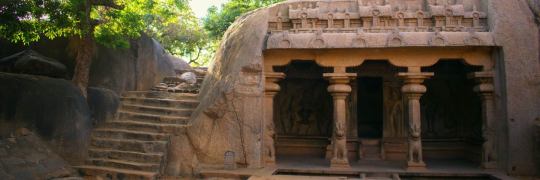
Masroor Temple at Kangra
The Masrur Temples, also referred to as Masroor Temples or Rock-cut Temples at Masrur, is an early 8th-century complex of rock-cut Hindu temples in the Kangra Valley of Beas River in Himachal Pradesh, India. The temples face northeast, towards the Dhauladhar range of the Himalayas. They are a version of North Indian Nagara architecture style, dedicated to Shiva, Vishnu, Devi and Saura traditions of Hinduism, with its surviving iconography likely inspired by a henotheistic framework. Though a major temples complex in the surviving form, the archaeological studies suggest that the artists and architects had a far more ambititious plan and the complex remains incomplete. Much of the Masrur's temple's sculpture and reliefs have been lost. They were also quite damaged, most likely from earthquakes.The temples were carved out of monolithic rock with a shikhara, and provided with a sacred pool of water as recommended by Hindu texts on temple architecture. The temple has three entrances on its northeast, southeast and northwest side, two of which are incomplete. Evidence suggests that a fourth entrance was planned and started but left mostly incomplete, something acknowledged by the early 20th-century colonial era archaeology teams but ignored leading to misidentification and erroneous reports. The entire complex is symmetrically laid out on a square grid, where the main temple is surrounded by smaller temples in a mandala pattern. The main sanctum of the temples complex has a square plan, as do other shrines and the mandapa. The temples complex features reliefs of major Vedic and Puranic gods and goddesses, and its friezes narrate legends from the Hindu texts.
The temple complex was first reported by Henry Shuttleworth in 1913 bringing it to the attention of archaeologists. They were independently surveyed by Harold Hargreaves of the Archaeological Survey of India in 1915. According to Michael Meister, an art historian and a professor specializing in Indian temple architecture, the Masrur temples are a surviving example of a temple mountain-style Hindu architecture which embodies the earth and mountains around it.
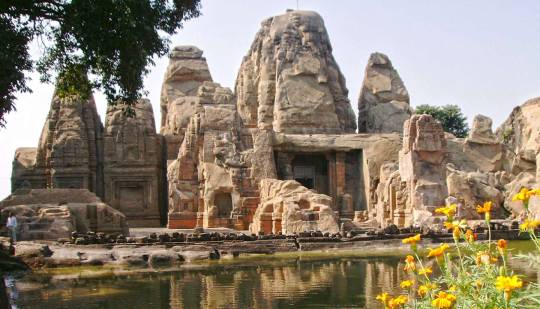
Bojjannakonda Buddhist Site,
Bojjannakonda and Lingalakonda are two Buddhist rock-cut caves on adjacent hillocks, situated near a village called Sankaram, which is a few kilometres away from Anakapalle, Vishakhapatnam in the Indian state of Andhra Pradesh. The sites are believed to date between 4th and 9th Century A.D, when the Buddhism (Hinayana, Mahayana, and Vajrayana) flourished at Sankaram (Sangharam as it was called then). The real name of Bojjannakonda was actually Buddina Konda but the people can't pronounce it properly by telling the name repeatedly so it was changed to Bojjannakonda . Sankaram, a small village, is situated about a mile to the east of Anakapalli in the Visakhapatnam district of Andhra Pradesh. A short distance to the north of the village are two hills, the one on the east called Bojjannakonda and the other on the west called Lingalakonda, both of which are surrounded by paddy fields. The hills contain numerous monolithic stupas, rock-cut caves, chaityas and monasteries forming one of the most remarkable Buddhist establishments in Andhra Pradesh during the period from the 4th to the 9th Century CE. The name of the village Sankaram is evidently a corruption of Sangharam (Boudha-arama, i.e., vihara) as these Buddhist establishments are generally known.

Guntupalle Buddhist Site,
The Guntupalle or Guntupalli Group of Buddhist Monuments is located near Kamavarapukota, West Godavari district, in the state of Andhra Pradesh in India. It is around 40 km away from Eluru. The rock-cut part of the site has two Buddhist caves, a chaitya hall and a large group of stupas. The chaitya hall has a rare carved stone entrance replicating wooden architecture, a simpler version of that at the Lomas Rishi Cave.There are remains of structural buildings in brick and stone, including remains of two vihara made of brick, as well as excavated caves at two levels, including an unusual structural chaitya hall (that is, one built above ground). The core of this consists of the stone stupa with an enclosed path around it allowing ritual parikrama (circumambulation). They mostly date to 200-0 BCE, with some sculptures added later. The main building above ground is in brick, around a stone stupa, with over 30 smaller stupas on a terrace in front of it. There are ruins of two other buildings.
During excavation, three relic caskets were found. The caskets had many precious elements like gold, silver, crystal beads. The bronze image of Padmapani was found along with one of the caskets. The inscription on the casket was in the Devanagari script which indicates the year as from the 9th to 10th century CE.
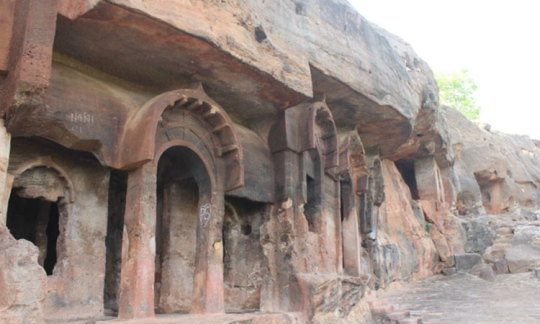
Ramatheertham,
Ramateertham is a village panchayat in Nellimarla mandal of Vizianagaram district in Andhra Pradesh in India.It is about 12 km from Vizianagaram city. It is a famous Pilgrimage and also Ancient Historical Site since 3rd Century BCE.Ramateertham is one of the places made sacred by a traditional connection with Rama. The temple and village at the base of a chain of hills of solid rock on which are some perennial springs of water, and various places each in a way associated with the name of Rama. The Jains have also had a residence here, their remains consisting chiefly of natural caves with slab sculptures set in them, and some small ruined brick temples. It is one of the few places in this direction where Jaina remains exist. The only notice of buried remains here is in Sewel's Lists (Vol. I, page 15) where mention is made of great heaps of broken bricks and cut stones on a hill which is difficult of access. It was hitherto unknown that these remains were Buddhist, and this I only discovered last season. Since that time, excavations have been conducted and resulted in the unearthing of an extensive part of what has undoubtedly been a large and important Buddhist monastery.
The Black Granite hills on which you can find the ruins of some Buddhist and Jain structures known as Bodhikonda. Apart from it there are two other hills by name Gurabaktakonda (Gurubhakthulakonda) and Ghani konda (also known as Durga Konda) on which you can find a 3rd-century BC Buddhist Monastic complex remains and rock-cut caves with Jain Tirthankara images on the walls of the caves.
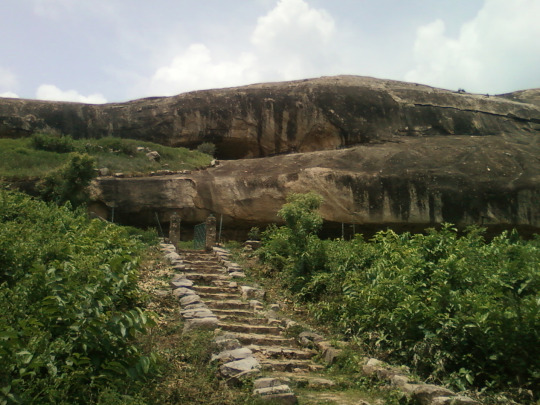
Aihole
Aihole (pronounced "Eye-hoḷé"), also referred to as Aivalli, Ahivolal or Aryapura, is a historic site of ancient and medieval era Buddhist, Hindu and Jain monuments in Karnataka, India dated from the sixth century through the twelfth century CE, though the most of the surviving monuments date from the 7th to 10th centuries. Located around an eponymous small village surrounded by farmlands and sandstone hills, Aihole is a major archaeological site featuring over one hundred and twenty stone and cave temples from this period, spread along the Malaprabha river valley, in Bagalakote district.Aihole is 22 miles (35 km) from Badami and about 6 miles (9.7 km) from Pattadakal, both of which are major centres of historically important Chalukya monuments. Aihole, along with nearby Badami (Vatapi), emerged by the 6th century as the cradle of experimentation with temple architecture, stone artwork, and construction techniques. This resulted in 16 types of free-standing temples and 4 types of rock-cut shrines. The experimentation in architecture and arts that began in Aihole yielded the group of monuments at Pattadakal, a UNESCO world heritage site.
Over one hundred Aihole temples are Hindu, a few are Jain and one is Buddhist. These were built and coexisted in close proximity. The site is spread over about 5 square kilometres (1.9 sq mi). The Hindu temples are dedicated to Shiva, Vishnu, Durga, Surya and other Hindu deities. The Jain Basadi temples are dedicated to Mahavira, Parshvanatha, Neminatha and other Jain Tirthankaras.[10] The Buddhist monument is a temple and small monastery. Both Hindu and Jain monuments include monasteries, as well as social utilities such as stepwell water tanks with artistic carvings near major temples.
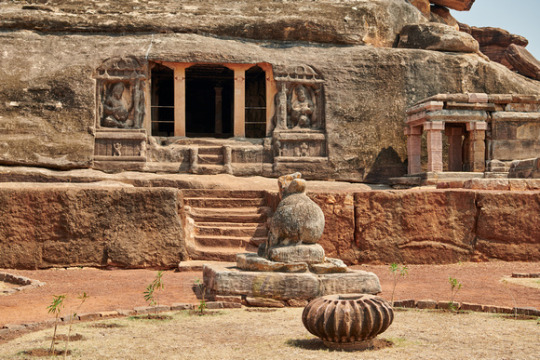
1 note
·
View note
Text

Salsette 27 in offers a blend of modern living and historical charm. This article will guide you through everything you need to know about these coveted 2 and 3 BHK properties in Byculla, touching on the locality, amenities, investment potential, and more.
0 notes
Text
Salsette 27 in Byculla: Premium 2 BHK and 3 BHK Flats in Byculla

Salsette 27 stands as a premier residential development in the heart of Byculla, Mumbai. As a distinguished project by Peninsula Land Ltd., Salsette 27 offers a blend of luxury, convenience, and modernity, setting a new benchmark in the real estate market. This article delves into the unique features of Salsette 27, highlighting its 2 BHK and 3 BHK flats, and provides a comprehensive overview of the floor plans and amenities that make it a desirable residential choice.
Salsette 27 is strategically located in Byculla, one of Mumbai's most vibrant and historical neighborhoods. The project features contemporary architecture and an array of high-end amenities that cater to the modern lifestyle. The residential complex is designed to offer an unparalleled living experience, blending elegance with functionality.
Prime Location and Connectivity
Situated in Byculla, Salsette 27 benefits from its proximity to major commercial hubs, educational institutions, and healthcare facilities. The location offers excellent connectivity to different parts of Mumbai via road and rail, making it a strategic choice for professionals and families alike.
Luxurious 2 BHK and 3 BHK Flats
Salsette 27 offers a range of residential options, including 2 BHK and 3 BHK flats, each meticulously designed to provide maximum comfort and convenience.
2 BHK Flats: Space and Elegance
The 2 BHK in Byculla are designed for those seeking a blend of spacious living and elegant design. These flats feature:
Open-Plan Living Areas: Spacious living and dining areas designed for comfort and functionality.
Modern Kitchens: Equipped with contemporary fixtures and fittings to make cooking a delightful experience.
Master Bedrooms: Designed with ample space and high-quality finishes for a restful retreat.
Balconies with Views: Offering panoramic views of the cityscape, adding a touch of luxury to everyday living.
3 BHK Flats: Ultimate Luxury
For those seeking more space, the 3 BHK flats in Salsette 27 offer a higher level of luxury and comfort. Key features include:
Expansive Living Areas: Generous living and dining spaces perfect for hosting gatherings.
Gourmet Kitchens: Featuring high-end appliances and finishes for an exceptional cooking experience.
Spacious Master Suite: Includes a private dressing area and en-suite bathroom.
Additional Bedrooms: Designed to offer privacy and comfort for family members or guests.
Large Balconies: Providing additional space for relaxation and outdoor dining with stunning views.
Floor Plans of Salsette 27
Detailed Layouts
The floor plans of Salsette 27 are designed to optimize space utilization and ensure flow and functionality. Each unit features:
Efficient Space Management: Ensuring that every square foot is used effectively.
Flexible Layouts: Offering options to personalize the living space according to individual needs.
Premium Finishes: High-quality materials and finishes that reflect luxury and sophistication.
Amenities and Facilities
Salsette 27 is not just about luxurious living spaces; it also offers a range of world-class amenities designed to enhance the quality of life for its residents.
Clubhouse and Recreational Facilities
The clubhouse at Salsette 27 provides a range of recreational options, including:
Swimming Pool: A beautifully designed pool for relaxation and exercise.
Fitness Center: Equipped with state-of-the-art gym equipment.
Community Hall: Ideal for social gatherings and events.
Conclusion
Salsette 27 Property in Byculla represents the pinnacle of luxury living in Mumbai. With its elegant design, spacious 2 BHK and 3 BHK flats, and world-class amenities, it offers an unparalleled residential experience. Whether you're looking for a new home or a lucrative investment opportunity, Salsette 27 is a choice that combines comfort, style, and value.
For more details visit our site: https://www.propmart.co/city/byculla/
0 notes
Text

Salsette27 is a residential project offering 2 BHK and 3 BHK luxury flats in Byculla in South Mumbai by Peninsula Land. Know more by visiting our website
0 notes
Text

Nestled in the heart of Mumbai’s vibrant landscape, Salsette 27 stands tall as an epitome of luxury living. This opulent property, located in Byculla, sets a new benchmark in sophistication, offering a range of meticulously designed 2BHK and 3BHK apartments that redefine contemporary urban living.
0 notes
Photo

Salsette 27 by Peninsula Land is luxury residential community offering Property in 2 bhk in Byculla Mumbai with Jain temple & natural pond starting @ 4.85 Cr. Know More : https://salsette27.com/luxuryresidences/
0 notes

